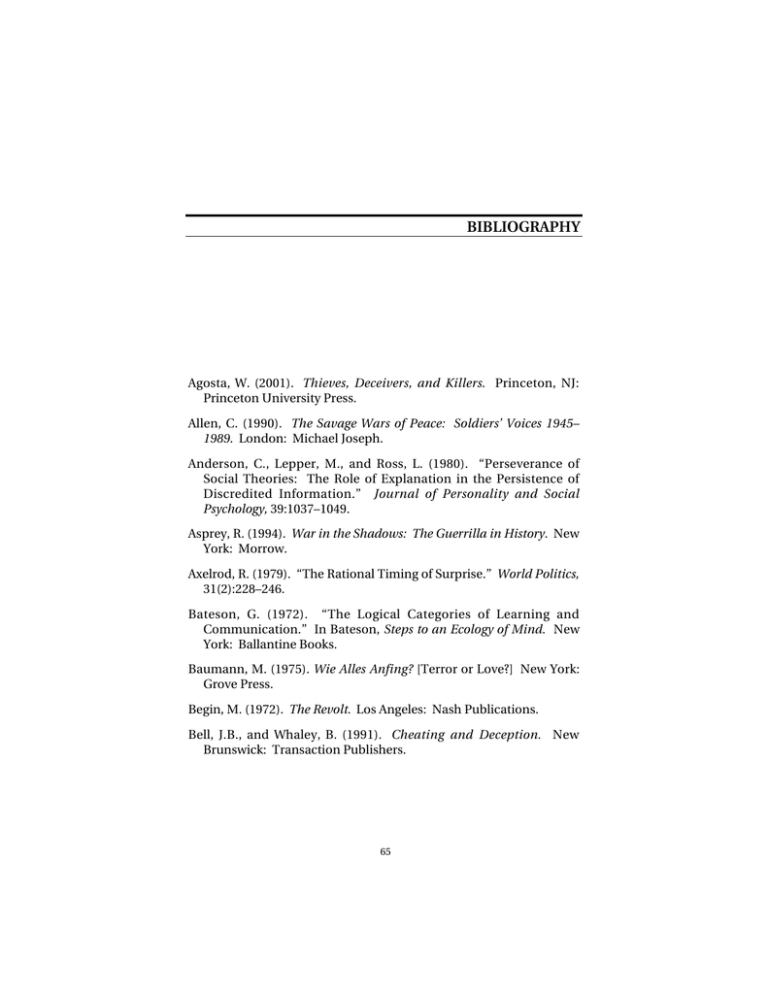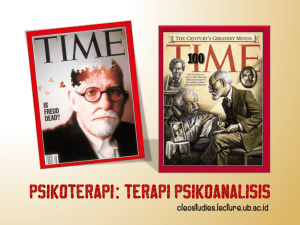BIBLIOGRAPHY
advertisement

BIBLIOGRAPHY Agosta, W. (2001). Thieves, Deceivers, and Killers. Princeton, NJ: Princeton University Press. Allen, C. (1990). The Savage Wars of Peace: Soldiers’ Voices 1945– 1989. London: Michael Joseph. Anderson, C., Lepper, M., and Ross, L. (1980). “Perseverance of Social Theories: The Role of Explanation in the Persistence of Discredited Information.” Journal of Personality and Social Psychology, 39:1037–1049. Asprey, R. (1994). War in the Shadows: The Guerrilla in History. New York: Morrow. Axelrod, R. (1979). “The Rational Timing of Surprise.” World Politics, 31(2):228–246. Bateson, G. (1972). “The Logical Categories of Learning and Communication.” In Bateson, Steps to an Ecology of Mind. New York: Ballantine Books. Baumann, M. (1975). Wie Alles Anfing? [Terror or Love?] New York: Grove Press. Begin, M. (1972). The Revolt. Los Angeles: Nash Publications. Bell, J.B., and Whaley, B. (1991). Cheating and Deception. New Brunswick: Transaction Publishers. 65 66 Unweaving the Web: Deception and Adaptation in Future Urban Operations Bell, J.B. (1991). IRA Tactics and Targets: An Analysis of Tactical Aspects of the Armed Struggle 1969–1989. New Brunswick: Transaction Publishers. Bell, J.B. (1997). The Secret Army: Transaction Publishers. The IRA. New Brunswick: Betts, R. (1982). Surprise Attack: Lessons for Defense Planning. Washington, D.C.: The Brookings Institution. Blum, R. (1972). Deceivers and Deceived: Observations on Confidence Men and Their Victims, Informants and Their Quarry, Political and Individual Spies and Ordinary Citizens. Illinois: C.C. Thomas. Brower, L. (1969). “Ecological Chemistry.” Scientific American, 220(2):22–29. Brown, L., and Amadon, D. (1968). Eagles, Hawks, and Falcons of the World. Feltham: Country Life Books. Christmas, R. (1977). “A Company Commander Remembers the Battle for Hue.” Marine Corps Gazette, February. Cohen, S. (1978). “Environmental Load and Allocation of Attention.” In A. Baum, J. Singer, and S. Valins (eds.), Advances in Environmental Psychology, vol. 1. New York: Halstead Press. Collins, E. (1997). Killing Rage. London: Granta Books. Collett, T., and Land, M. (1978). “How Hoverflies Compute Interception Courses.” Journal of Comparative Physiology, 125:191–204. Cott, H. (1966). Adaptive Coloration in Animals, 3rd edition. London: Methuen & Co. Courand, G. (1989). Counter Deception. Advanced Decision Systems. Mountain View, CA: Cruickshank, C. (1979). Deception in World War Two. New York: Oxford University Press. Curio, E. (1976). The Ethology of Predation. Berlin: Springer-Verlag. Curtis, N. (1998). Faith and Duty. London: Andre Deutsch. Bibliography 67 Daalder, I., and O’Hanlon, M. (2000). Winning Ugly: NATO’s War to Save Kosovo. Washington, D.C.: The Brookings Institution. Daniel, D., and Herbig, K. (1982). Strategic Military Deception. New York: Pergamon Press. Davies, N., and Brooke, M. (1988). “Cuckoos Versus Reed Warblers: Adaptations and Counter-Adaptations.” Animal Behaviour, 36:262–284. Davies, N., and Brooke, M. (1989a). “An Experimental Study of Coevolution Between the Cuckoo Cuculus canorus and Its Hosts. I. Egg Discrimination.” Journal of Animal Ecology, 58:207–224. Davies, N., and Brooke, M. (1989b). “An Experimental Study of Coevolution Between the Cuckoo Cuculus canorus and Its Hosts. II. Host Egg Markings, Chick Discrimination, and General Discussion.” Journal of Animal Ecology, 58:225–236. Dawkins, M. (1971). “Perceptual Changes in Chicks: Another Look at the ‘Search Image’ Concept.” Animal Behaviour, 19:566–574. Dawkins, R., and Krebs, J. (1978). “Animal Signals: Information or Manipulation?” In J. Krebs and N. Davies (eds.), Behavioral Ecology: An Evolutionary Approach. Oxford: Blackwell Scientific, 282–309. Dawkins, R., and Krebs, J. (1979). “Arms Races Between and Within Species.” Proceedings of the Royal Society of London, Series B, 205: 489–511. Dewar, M. (1989). The Art of Deception in Warfare. Newton Abbot, Devon: David & Charles. Dewar, M. (1992). War in the Streets: The Story of Urban Combat from Calais to Khafji. Newton Abbot, Devon: David & Charles. Donnelly, T., Roth, M., and Baker, C. (1991). Operation Just Cause: The Storming of Panama. New York: Lexington Books. Dunnigan, J., and Nofi, A. (1995). Victory and Deceit: Dirty Tricks at War. New York: W. Morrow. 68 Unweaving the Web: Deception and Adaptation in Future Urban Operations Eagly, A., Wood, W., and Chaiken, S. (1978). “Causal Inferences About Communicators and Their Effect on Opinion Change.” Journal of Personality and Social Psychology, 36:424–435. Edwards, Sean J.A. (2001). Freeing Mercury’s Wings: Improving Tactical Communications in Cities. Santa Monica, CA: RAND, MR-1316-A. Eldredge, N. (1980). “An Extravagance of Species: The Diversity of Fossil Trilobites Poses a Challenge to Traditional Evolutionary Theory.” Natural History, 89(7):46–51. Ellefsen, D. (1987). Urban Terrain Zone Characteristics. Aberdeen Proving Ground: U.S. Army Human Engineering Labs. Endler, J. (1980). “Natural Selection on Color Patterns in Poecilia Reticulata.” Evolution, 34:76–91. Endler, J. (1983). “Natural and Sexual Selection on Color Patterns in Poeciliid Fishes.” Environmental Biology of Fishes, 9:173–190. Endler, J. (1991). “Interactions Between Predators and Prey.” In J. Krebs and N. Davies (eds.), Behavioural Ecology: An Evolutionary Approach. Boston: Blackwell Scientific Publications, pp. 169–196. Endler, J. (1992). “Signals, Signal Conditions, and the Direction of Evolution.” American Naturalist, 139 (Supplement):125–153. Erichsen, J., Krebs, J., and Houston, A. (1980). “Optimal Foraging and Cryptic Prey.” Journal of Animal Ecology, 49:271–276. Farnham, D.E. (1988). “Logic for Intelligence Analysts.” In R. Garst (ed.), A Handbook of Intelligence Analysis. Defense Intelligence College. Fein, S., Hilton, J., and Miller, D. (1990). “Suspicion of Ulterior Motivation and Correspondence Bias.” Journal of Personality and Social Psychology, 58:753–764. Fein, S., and Hilton, J. (1994). “Judging Others in the Shadow of Suspicion.” Motivation and Emotion, 18:167–198. Gall, C., and De Waal, T. (1998). Chechnya: Calamity in the Caucasus. New York: New York University Press. Bibliography 69 George, A. (1972). “The Case for Multiple Advocacy in Making Foreign Policy.” American Political Science Review, 66. George, A. (1993). “The Role of Knowledge in Policy-Making.” In A. George (ed.), Bridging the Gap: Theory and Practice in Foreign Policy. Washington, D.C.: U.S. Institute of Peace Press. Gerwehr, S., and Glenn, R. (2000). The Art of Darkness: Deception and Urban Operations. Santa Monica, CA: RAND, MR-1132-A. Gilbert, D., and Jones, E. (1986). “Perceiver-Induced Constraint: Interpretations of Self-Generated Reality.” Journal of Personality and Social Psychology, 50:269–280. Gittleman, J., and Harvey, P. (1980). “Why Are Distasteful Prey Not Cryptic?” Nature, 286:149–150. Glantz, D. (1989). Soviet Military Deception in the Second World War. London: Frank Cass. Glenn, R. (1996). Combat in Hell: A Consideration of Constrained Urban Warfare. Santa Monica, CA: RAND, MR-780-A. Glenn, R. (1998). Marching Under Darkening Skies: The American Military and the Impending Urban Operations Threat. Santa Monica, CA: RAND, MR-1007-A. Glenn, R. (1999). “ . . . We Band of Brothers”: The Call for Joint Urban Operations Doctrine. Santa Monica, CA: RAND, DB-270-JS/A. Goldthwaite, R., Coss, R., and Owings, D. (1990). “Evolutionary Dissipation of an Antisnake System: Differential Behavior by California and Arctic Ground Squirrels in Above- and BelowGround Contexts.” Behavior, 112:246–269. Greenberg, I. (1982). “Role of Deception in Decision Theory.” Journal of Conflict Resolution, 26/1:139–156. Guilford, T. (1986). “How Do ‘Warning Colors’ Work? Conspicuousness May Reduce Recognition Errors in Experienced Predators.” Animal Behaviour, 34:286–288. Guilford, T., and Dawkins, M. (1991). “Receiver Psychology and the Evolution of Animal Signals.” Animal Behaviour, 39:706–716. 70 Unweaving the Web: Deception and Adaptation in Future Urban Operations Hammel, E. (1985). The Root: The Marines in Beirut, August 1982– February 1984. San Diego: Harcourt Brace Jovanovich. Hammel, E. (1991). Fire in the Streets: The Battle for Hue, Tet 1968. Chicago: Contemporary Books. Handel, M. (1985). Military Deception in Peace and War. Jerusalem: Hebrew University. Harris, W. (1970). “Counter-Deception Planning: Strategy and Organization.” Unpublished RAND research. Hartcup, G. (1979). Camouflage: A History of Concealment and Deception in War. North Pomfret, Vermont: David & Charles. Hass, R., and Grady, K. (1975). “Temporal Delay, Type of Warning, and Resistance to Influence.” Journal of Experimental Social Psychology, 11:459–469. Haykal, M. (1975). The Road to Ramadan. New York: New York Times Book Co. Herek, G., Janis, I., and Huth, P. (1987). “Decision-Making During International Crises: Is Quality of Process Related to Outcome?” Journal of Conflict Resolution, 31(2):203–226. Hilton, J., Fein, S., and Miller, D. (1993). “Suspicion and Dispositional Inference.” Personality and Social Psychology Bulletin, 19:501–512. Hoffman, B. (1997). “Why Terrorists Don’t Claim Credit.” Terrorism and Political Violence, 9(1):1–6. Holldobler, B. (1971). “Communication Between Ants and Their Guests.” Scientific American, 224:86–93. Houde, A., and Endler, J. (1990). “Correlated Evolution of Female Mating Preferences and Male Color Patterns in the Guppy Poecilia Reticulata.” Science, 248:1405–1408. Jaber, H. (1997). Hezbollah: Born with a Vengeance. New York: Columbia University Press. Bibliography 71 Janis, I., and Mann, L. (1977). Decisionmaking: A Psychological Analysis of Conflict, Choice, and Commitment. New York: Free Press. Janis, I. (1989). Crucial Decisions: Leadership in Policy-Making and Management. New York: Free Press. Jenkins, B. (1971). The Five Stages of Urban Guerrilla Warfare: Challenges of the 1970s. Santa Monica, CA: RAND, P-4670. Jervis, R. (1968). “Hypotheses on Misperception.” World Politics, 20(3):454–479. Jervis, R. (1976). Perception and Misperception in International Politics. Princeton, NJ: Princeton University Press. Johnston, T., and Turvey, M. (1980). “A Sketch of an Ecological Metatheory for Theories of Learning.” Psychology of Learning and Motivation, 14:147–205. Kacha, P., and Petr, V. (1995). “Camouflage and Mimicry in Fossils.” Acta Musei Nationalis Pragae, Ser. B, Historia Naturalium, 51(1– 4):53–82. Kahneman, D., and Tversky, A. (1983). “Choices, Values, Frames.” American Psychologist, 39(4):341–350. Kelley, H. (1973). “The Processes of Causal Attribution.” American Psychologist, 28:107–128. Koehler, D. (1991). “Explanation, Imagination, and Confidence in Judgement.” Psychological Bulletin, 110:499–519. Krebs, J., and Davies, N. (1993). Introduction to Behavioral Ecology, 3rd ed. Oxford: Blackwell. Kruglanski, A. (1987). “Motivation Effects in the Social Comparison of Opinions.” Journal of Personality and Social Psychology, 53: 834–842. Lambert, D.R. (1987). A Cognitive Model for the Exposition of Human Deception and Counterdeception. Washington, D.C.: Naval Materiel Command, NOSC TR 1076. 72 Unweaving the Web: Deception and Adaptation in Future Urban Operations Lamont, A. (1967). “Environmental Significance of Eye-Reduction in Trilobites and Recent Arthropods: Additional Remarks.” Marine Geology, 5:377–378. Lamont, A. (1969). “Prolegomena To Aggressive Mimicry And Protective Resemblance In Early Fishes, Chelicerates, Trilobites And Brachiopods.” Scottish Journal of Science, 1(2):75–103. Lieven, A. (1998). Chechnya: Tombstone of Russian Power. New Haven, CT: Yale University Press. Lloyd, J. (1975). “Aggressive Mimicry in Photuris Fireflies: Signal Repertoires by Femmes Fatales.” Science, 187:452–453. Lloyd, M. (1997). The Art of Military Deception. London: Leo Cooper. Lotem, A., Nakamura, H., and Zahavi, A. (1992). “Rejection of Cuckoo Eggs in Relation to Host Age: A Possible Evolutionary Equilibrium.” Behavioral Ecology, 3:128–132. Marighella, C. (1968). “Mini-Manual of the Urban Guerrilla.” In R. Moss, Urban Guerrilla Warfare. London: Adelphi Paper No. 79. Mathtech Inc. (1980). Deception Maxims, Fact and Folklore. Washington, D.C.: Office of Research and Development, Central Intelligence Agency. Matsulenko, V. (1974). “Operativnaya maskirovka voisk v kontranastuplenii pod Stalingradom” [Operational Maskirovka of Forces at Stalingrad]. VIZh, No. 1, January. May, R., and Robinson, S. (1985). “Population Dynamics of Avian Brood Parasitism.” American Naturalist, 126:475–484. McCleskey, E. (1991). Applying Deception to Special Operations Direct Action Missions. Washington, D.C.: Defense Intelligence College. McConnell, M. (1991). Just Cause. New York: St. Martin’s Press. McCormick, G. (1990). The Shining Path and the Future of Peru. Santa Monica, CA: RAND, R-3781-DOS/OSD. Bibliography 73 McCormick, G. (1992). From the Sierra to the Cities: The Urban Campaign of the Shining Path. Santa Monica, CA: RAND, R-4150USDP. McGuire, W., and Papageorgis, D. (1962). “Effectiveness of Forewarning in Developing Resistance to Persuasion.” Public Opinion Quarterly, 26:24–34. McLaurin, R.D., and Snider, L.W. (1982). Recent Military Operations in Urban Terrain. Aberdeen Proving Ground: U.S. Army Human Engineering Labs. Menzel, E. (1974). “A Group of Young Chimpanzees in a One-Acre Field.” In A. Schrier and F. Stollnitz (eds.), Behavior of Nonhuman Primates: Modern Research Trends, Vol. 5. New York: Academic Press. Milgram, S. (1970). “The Experience of Living in Cities.” Science, 13:1461–1468. Miller, J. (1980). “Urban Terrorism in Uruguay: The Tupamaros.” In B. O’Neill, W. Heaton, and D. Alberts (eds.), Insurgency in the Modern World. Boulder, CO: Westview Press. Mitchell, R. (1986). “A Framework for Discussing Deception.” In R. Mitchell and N. Thompson (eds.), Deception: Perspectives on Human and Nonhuman Deceit. New York: SUNY Press. Moksnes, A., Roskaft, E., Braa, A., Korsnes, L., Lampe, H., and Pedersen, H. (1991). “Behavioral Responses of Potential Hosts Towards Artificial Cuckoo Eggs and Dummies.” Behavior, 116:64– 89. Monmonier, M. (1996). How To Lie With Maps. Chicago: University of Chicago Press. Montagu, E. (1978). Beyond Top-Secret Ultra. New York: Coward, McCann, Geoghegan. New York Times (1999). “Serb Is Killed in Gun Battle with Marines,” June 23. New York Times (1999). Expected,” June 27. “Damage to Serb Military Less Than 74 Unweaving the Web: Deception and Adaptation in Future Urban Operations New York Times (2000). “In Long Fight with Israel, Hezbollah Tactics Evolved,” July 19. New York Times (2000). “Wasp Invades a Spider and Puts It to Work,” July 25. O’Neill, B., Heaton, W., and Alberts, D. (eds.) (1980). Insurgency in the Modern World. Boulder, CO: Westview Press. Owen, D. (1980). Camouflage and Mimicry. Chicago: University of Chicago Press. Owings, D., and Coss, R. (1977). “Snake Mobbing by California Ground Squirrels: Adaptive Variation and Ontogeny.” Behaviour, 62:50–69. Papageorgis, D. (1968). “Warning and Persuasion.” Psychological Bulletin, 70:271–282. Pavkovic, A. (2000). The Fragmentation of Yugoslavia: Nationalism and War in the Balkans. New York: St. Martin’s Press. Petty, R., and Cacciopo, J. (1977). “Forewarning, Cognitive Responding, and Resistance to Persuasion.” Journal of Personality and Social Psychology, 35:645–655. Pietrewicz, A., and Kamil, A. (1981). “Search Images and the Detection of Cryptic Prey: An Operant Approach.” In A. Kamil and T. Sargent (eds.), Foraging Behavior: Ecological, Ethological, and Psychological Approaches, pp. 311–332. New York: Garland STPM Press. Poran, N., and Coss, R. (1990). “Development of Antisnake Defences in California Ground Squirrels Spermophilus beechyi: I. Behavioral and Immunological Relationships.” Behaviour, 112:222–245. Pratkanis, A., and Aronson, E. (2001). Age of Propaganda: The Everyday Use and Abuse of Persuasion. New York: W.H. Freeman & Co. Rapoport, D. (1997). “To Claim or Not To Claim; That Is the Question—Always!” Terrorism and Political Violence, 9(1):11–17. Bibliography 75 Rohwer, S., and Spaw, C. (1988). “Evolutionary Lag Versus Bill-Size Constraints: a Comparative Study of the Acceptance of Cowbird Eggs by Old Hosts.” Evolutionary Ecology, 2:27–36. Roper, T., and Redston, S. (1987). “Conspicuousness of Distasteful Prey Affects the Strength and Durability of One-Trial Avoidance Learning.” Animal Behaviour, 35:739–747. Ross, L., and Anderson, C. (1982). “Shortcomings in Attribution Processes: On the Origins and Maintenance of Erroneous Social Judgements.” In D. Kahneman, P. Slovic, and A. Tversky (eds.), Judgement Under Uncertainty: Heuristics and Biases. New York: Cambridge University Press. Rothstein, S. (1974). “Mechanisms of Avian Egg Recognition: Possible Learned and Innate Factors.” Auk, 91:796–807. Rothstein, S. (1982). “Mechanisms of Avian Egg Recognition: Which Eggs Elicit Responses by Rejector Species?” Behavioral Ecology and Sociobiology, 11:229–239. Rothstein, S. (1990). “A Model System for Coevolution: Avian Brood Parasitism.” Annual Review of Ecology and Systematics, 21:481– 508. Royama, T. (1970). “Factors Governing the Hunting Behavior and Selection of Food by the Great Tit, Parus major.” Journal of Animal Ecology, 39:619–668. Rue, L. (1994). By The Grace of Guile. New York: Oxford University Press. Sargent, T. (1981). “Antipredator Adaptations of Underwing Moths.” In A. Kamil and T. Sargent (eds.), Foraging Behavior: Ecological, Ethological, and Psychological Approaches, pp. 259–284. New York: Garland STPM Press. Schecter, G., and Farrar, D. (1983). Camouflage in Built Up Areas. McLean, VA: McLean Research Center. DTIC ADB074334. Schlenoff, D. (1985). “The Startle Responses of Blue Jays to Catocala (Lepidoptera: Noctuidae) Prey Models.” Animal Behaviour, 33:1057–1067. 76 Unweaving the Web: Deception and Adaptation in Future Urban Operations Schofield, V. (2000). Kashmir in Conflict: India, Pakistan, and the Unfinished War. London, New York: I.B. Tauris. Schul, Y., Burnstein, E., and Martinez, J. (1983). “The Informational Basis of Social Judgements: Under What Conditions are Inconsistent Trait Descriptions Processed as Easily as Consistent Ones?” European Journal of Social Psychology, 13:143–151. Schul, Y., and Burnstein, E. (1985). “When Discounting Fails: Conditions Under Which Individuals Use Discredited Information in Making a Judgement.” Journal of Personality and Social Psychology, 49:894–903. Schul, Y., and Mazursky, D. (1990). “Conditions Facilitating Successful Discounting in Consumer Decision-Making.” Journal of Consumer Research, 16:442–451. Schul, Y. (1993). “When Warning Succeeds: The Effect of Warning on Success of Ignoring Invalid Information.” Journal of Experimental Social Psychology, 29:42–62. Schul, Y., Burnstein, E., and Bardi, A. (1996). “Dealing with Deceptions That Are Difficult to Detect: Encoding and Judgement as a Function of Preparing to Receive Invalid Information.” Journal of Experimental Social Psychology, 32:228–253. Schultz, R. (1999). The Secret War Against Hanoi. New York: HarperCollins. Singh, J. (1999). Kargil 1999: Pakistan’s Fourth War for Kashmir. New Delhi: Knowledge World. Slatkin, M., and Maynard Smith, J. (1979). “Models of Coevolution.” Quarterly Review of Biology, 54:233–263. Smith, S. (1977). “Coral Snake Pattern Rejection and Stimulus Generalization by Naive Great Kiskadees (Aves: Tyrannidae).” Nature, 265:535–536. Snyder, M., and Jones, E. (1974). “Attitude Attribution When Behavior Is Constrained.” Journal of Experimental Social Psychology, 10:585–600. Bibliography 77 Soler, M., and Moller, A. (1990). “Duration of Sympatry and Coevolution Between the Great Spotted Cuckoo and its Magpie Host.” Nature, 343:748–750. Srinivasan, M., and Davey, M. (1995). “Strategies for Active Camouflage of Motion.” Proceedings of the Royal Society of London, Series B, 259:19–25. Stanley, R. (1998). To Fool a Glass Eye: Camouflage Versus Photoreconnaissance in WWII. Washington, D.C.: Smithsonian. Stebbins, R. (1975). “Putting People On: Deception of Our Fellow Man in Everyday Life.” Sociology and Social Research, 59(3):189– 200. Taw, J., and Hoffman, B. (1994). The Urbanization of Insurgency: The Potential Challenge to U.S. Army Operations. Santa Monica, CA: RAND, MR-398-A. Tetlock, P., Peterson, R., McGuire, C., Chang, S., and Feld, P. (1992). “Assessing Political Group Dynamics: A Test of the Groupthink Model.” Journal of Personality and Social Psychology, 63(3):403– 425. Thomas, T. (1997). The Caucasus Conflict and Russian Security: The Russian Armed Forces Confront Chechnya, I, II, III. Fort Leavenworth, KS: U.S. Army Foreign Military Studies Office. Thulborn, T. (1994). “Mimicry in Ankylosaurid Dinosaurs.” Records of the South Australian Museum, 27(2):151–158. Tinbergen, L. (1960). “The Natural Control of Insects in Pinewoods. I. Factors Influencing the Intensity of Predation by Song Birds.” Archs. Neerl. Zool, 13:265–343. Tversky, A., and Kahneman, D. (1971). The Belief in the Law of Small Numbers. Psychological Bulletin 76: 105–110. Tversky, A., and Kahneman, D. (1974). “Judgment Under Uncertainty: Heuristics and Biases.” Science, 185:4157. United States Army (1988). Battlefield Deception, Field Manual 90-2. 78 Unweaving the Web: Deception and Adaptation in Future Urban Operations United States Air Force, Headquarters (2000). The Air War Over Serbia: Aerospace Power in Operation Allied Force. United States Defense Department Joint Camouflage, Concealment, and Deception Program (1995). DOT&E annual report. United States Joint Publication 1-02 (1993): DoD Dictionary of Military and Associated Terms. United States Joint Publication 3-58 (1996): Joint Doctrine for Military Deception. Vinogradov, B. (1995). “Moscow Has Stated: Military Phase Is Over, Fighting in Grozny Continues.” Izvestiya, January 21, p. 1. Whaley, B. (1969). Stratagem: Deception and Surprise in War. Cambridge: MIT Center for International Studies. Whaley, B. (1982). “Toward a General Theory of Deception.” In J. Gooch and A. Perlmutter (eds.), Military Deception and Strategic Surprise. London: Frank Cass. Wickler, W. (1968). Mimicry in Plants and Animals. New York: McGraw-Hill.






